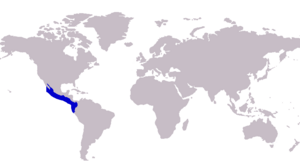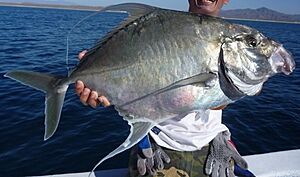Threadfin jack facts for kids
Quick facts for kids Threadfin jack |
|
|---|---|
 |
|
| Conservation status | |
| Scientific classification | |
 |
|
| Approximate range of the threadfin jack | |
| Synonyms | |
|
The threadfin jack or thread pompano (Carangoides otrynter) is a cool type of fish that lives in the ocean. It belongs to the jack family called Carangidae. You can find this fish in the warm waters of the eastern Pacific Ocean. Its home ranges from Baja California in the north all the way down to Ecuador and the Galapagos Islands.
This fish can grow quite large, up to about 60 centimeters (2 feet) long! You can easily spot it because of the long, thin parts on its back fin (dorsal fin) and bottom fin (anal fin). These long parts look like threads, which is how it got its name.
Threadfin jacks live in different parts of the ocean. They can be found in deeper coastal waters and closer to shore. This includes places like reefs and estuaries (where rivers meet the sea). They eat tiny creatures that live on the seafloor or swim in the open water. This includes small fish and crustaceans like crabs and shrimp.
People catch threadfin jacks for food. They use hooks and nets. This fish is known to be very tasty!
Contents
About the Threadfin Jack's Name
The threadfin jack has a scientific name, Carangoides otrynter. Scientists use these special names so everyone around the world knows exactly which animal they are talking about.
An American fish expert named Theodore Gill first described this fish. He gave it the name Carangoides dorsalis in 1863. Later, two other American fish experts, David Starr Jordan and Charles Henry Gilbert, gave it the name Caranx otrynter in 1883. This new name helped avoid confusion with another fish that had a very similar name.
The word otrynter comes from Latin and means "a driver." This name refers to the long, whip-like ray on its second dorsal fin. The common names, threadfin jack and thread pompano, also describe these long, thread-like fins.
What Does the Threadfin Jack Look Like?
The threadfin jack is a medium-sized fish. It can grow up to 60 centimeters (about 2 feet) long. Its body is flat from side to side and shaped like a rectangle with rounded corners.
Its head has a sharp angle, especially above its mouth. Young threadfin jacks look a bit different. They are more oval or diamond-shaped, similar to young fish from the Alectis group.
The fish has two main back fins. The first one is very small and has eight hidden spines. The second back fin has one spine and 18 or 19 soft rays. The fin on its belly (anal fin) has two spines at the front, followed by one spine and 16 or 17 soft rays. Both young and adult fish have very long, thread-like tips on their second back fin and belly fin. These "threads" are longest on the younger fish.
The side line of the fish, called the lateral line, has a curved part at the front and a straight part at the back. The straight part has small scales and bony plates called scutes. The area below its head and belly is smooth, without scales. Both its upper and lower jaws have small, weak teeth.
When alive, the threadfin jack is shiny blue-silver on top and white-silver underneath. It might have golden or yellow reflections. Its first back fin and belly fins are gray. The other fins are clear or gray with a yellow tint. Young fish have dark stripes that fade as they get older. They also have small black spots near their back fin and a black spot on their gill cover.
Where the Threadfin Jack Lives
The threadfin jack lives in the warm, tropical parts of the eastern Pacific Ocean. You can find it along the western coast of the Americas. Its northern home is southern Baja California in Mexico. It lives south through Mexico and Central America down to Ecuador. It also lives around the Galapagos Islands.
This fish is one of only two types of Carangoides fish found along the western coast of the Americas. The other is the island trevally.
Young threadfin jacks often swim in the open ocean. Ocean currents can carry them to far-off islands like the Galapagos. As they get older, they tend to live closer to the bottom of the ocean. They prefer coastal waters and reefs.
Smaller fish have been seen in estuaries, creeks lined with mangrove trees, shallow bays, and lagoons. Larger fish live in deeper waters, sometimes as deep as 50 meters (about 164 feet).
Threadfin Jack: Diet and Importance to People
Scientists don't know much about the full life of the threadfin jack. But they have studied what it eats! A study in Colombia found that these fish mainly eat small fish that live on the ocean floor. They also eat crustaceans like different types of crabs and shrimp. We still don't know much about how they reproduce or their full life cycle.
The threadfin jack is important to people who fish for a living. While we don't have exact numbers, it's often caught using hooks and lines, or with gill nets and other simple traps. People think it's a very good fish to eat. It's sold fresh or salted.
People have been catching and eating threadfin jacks for a very long time. Evidence from old human sites in Panama and Ecuador shows that people have eaten this fish for at least 3,450 years!
Anglers (people who fish for fun) also sometimes catch threadfin jacks. Younger fish can be caught from shore, like from piers or breakwaters. Larger fish are caught over deeper reefs. These fish will bite on different kinds of bait, like small fish and prawns. They also go after lures, including small, fly-like Sabiki lures.
Images for kids





